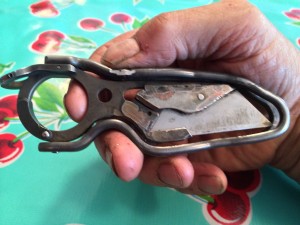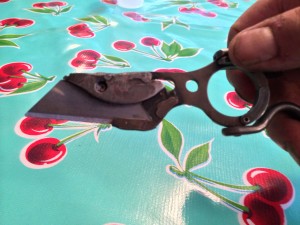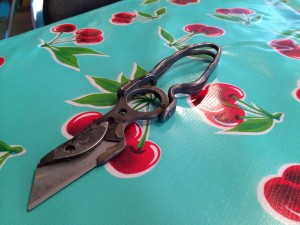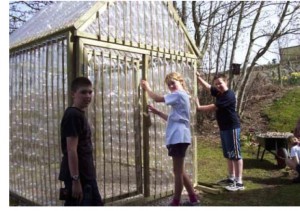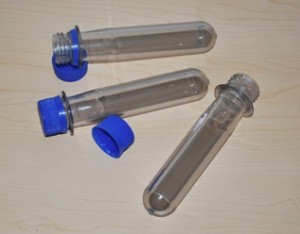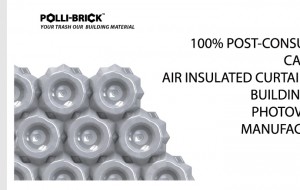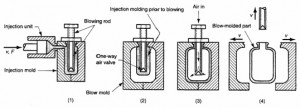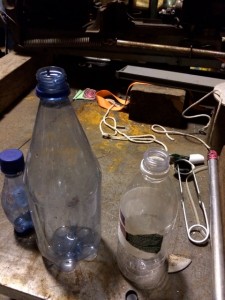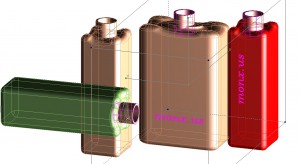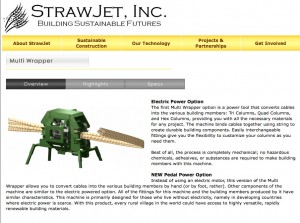This is a one off that I am selling on ebay. it is a prototype for a utilty knife based on the Hole in one chassis. It features a retro screw lock and rough finish on the blade holder. I have been carrying this around for a few months now and am happy with how it performs. I am building a newer prototype with a toggle blade lock.
Inventions
Bottle Blocks
in order to save resources provide affordable shelter and reduce plastic waste behold bottle blocks:
This is currently being done in a variety of ways such as simply stacking bottles, either empty of filled with earth.
http://www.home-designing.com/2009/12/bizarre-house-made-up-of-bottles
Polli brick melts down bottles and recreates a part called a parison (image below right), this requires very precise engineering, and a very expensive plastic injection molding machine (image below) to make.
The Parison is then blown into the polli-brick shape.
http://www.miniwiz.com/miniwiz/en/products/living/polli-brick see this video for technical details of how a polli-brick is created.
http://www.miniwiz.com/miniwiz/en/projects/polli-boat/item/2 see this video for the story of how all this came together, funding, project & people.
What is new. The method I envision can easily reform bottles into a single common shape designed to create structures. It eliminates the complex and costly injection mold and press. $1M estimated needed for the Polli bottle. And replaces it with extremely simple, easily copied tooling made from materials available in even very primitive regions.
How does it work?
The basic principle here is that when bottles are blown, they want to shrink, but can’t because the plastic is cooled and solidified when the bottle is placed into a mold and compressed air is forced into it defining it’s unique shape while it cools and hardens.
Reheating bottles allows them to shrink back towards the original test tube (parison)(see images below) shape of the injection molded part they started as. Inflating them in a different mold reforms them into a new uniform and stackable shape.
Below is a schematic of how the Polli Brick is produced, my process replaces the first and most costly and complex step (recreating the parison) with an existing bottle which is then shrunken to the parison like shape, then re-blown into the block mold.
The bottle on the left was the size of the bottle on the far right before heat shrinking.
A primitive idea of the reformatted bottles appears below.
Tests I have done show that the typical bottle will shrink to about half the size of the full shape. While the bottle is still soft, it is re-blown into a new shape, that of the bottle block. Through this method, a diverse array of bottles of similar volume can be reshaped to a single, uniform structural component.
Bioengineering:
I am envisioning the bottle block filled with a mycylial mix, such as Ecovative is currently demonstrating. The bottles provide a natural mold for mycilial growth, the food provided by local waste plant material. The combination of the mycilial growth through the plant material increases its strength, fire resistance and insulatory properties.
Alone the bottles are very combustible, but with the myclia adjacent to it, it is much less easily burned because of the greatly reduced surface area. The bottles provide a sealed membrane to maintain a desired environment inside and out, both during growth and use phases. The amount of moisture could be selected based on a variety of parameters. The myclia is encapsulated, the adjacent surfaces, smooth and nonporous, provides a barrier to prevent degradation from weather and damaging life forms, ie termites, mold.
Criteria for structural materials. During my two years at Strawjet, http://www.youtube.com/watch?v=bVUESLP3lKU
I learned of the incredible complexity of providing a novel building material.
Strength, fire, weather, mould and insect, plant and animal damage are just some of the issues to be addressed to succeed.
And lower cost than comparable solutions.
Embeded Energy: Captures more of the embeded energy in the bottle, requires heat: 400° oven or hot liquid, and time to create. approximately equal to the heat needed to dip it in boiling water for 30 seconds.
Tools: Cleaning tank, blow pipe that can grasp diverse neck shapes, resist heat and deliver valved compressed air to re-inflate the bottle. Heat source to reformat the bottle. oven or hot liquid around 400 deg f. Mold to produce shape. can be cast in concrete, 2 pcs, copied from any brick.
Starting with safety, materials need to be tested for consistent strengths, compression and failure analysis needs to be done. Initially the bottle blocks can be used as infill while the strength is evaluated and explored.
Explore the viability of various growth media and innoculants.
Various interlock, fastening and sealing strategies need to be evolved.
What lies ahead?
The critical path for me is to determine that the reformatting process is simple, robust and easily copied. This involves getting the blow tube & clamp a little more refined, and the compressed air connection, then make and test some simple molds. This will show me that there aren’t any early deal breakers, such as blowouts or inability to reform or make a useful shape. I don’t expect this, and will get good feedback on temperature, pressure and optimum re-expansion size and shape, and what geometries and tolerances can be held.
The next phase will be to design the “universal brick” this will involve the feedback from above, with a study of the parameters of the actual bricks. The goal being to create an easily created part, requiring few tools, little energy and minimal skills to transform bottles into a shape that can be used in a variety of ways to build structures to condition and create space.
Defining the optimum brick shape involves many parameters such as symmetry, stacking patterns, dealing with foundations, doors, windows and corners to name a few.
Part of creating the universal brick will be exploring the unique characteristics of the product. The media is more compliant than conventional material, such as bricks but lighter.
Even two dimensional tiling is complex as seen below. three dimensional interlocking parts are even more so, with a Rubic’s cube like variety of options.
http://www.geoaustralia.com/english/Sphinx/Guide.html
Help! I’m a Giant 3D Printer stuck in a Lathe’s Body!
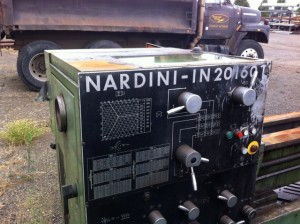 I am Nardini, a giant metal lathe of Brazillian origin. I desperately need your help! I am currently being held hostage and threatened with extinction (or at least being broken up into tiny pieces sent to China and returned as tiny flag pins for Wal-Marters). I have seemingly been rescued from that fate, although it is unclear if I can get sufficient help from the local humanoid types to complete my escape and metamorphosis to a giant 3D printer.
I am Nardini, a giant metal lathe of Brazillian origin. I desperately need your help! I am currently being held hostage and threatened with extinction (or at least being broken up into tiny pieces sent to China and returned as tiny flag pins for Wal-Marters). I have seemingly been rescued from that fate, although it is unclear if I can get sufficient help from the local humanoid types to complete my escape and metamorphosis to a giant 3D printer.
Hole in One – Durability
Both blade and frame have a durable non-reflective bead-blast finish.
Tom says,
“This is not a high-force knife, but a versatile, fun, outdoor knife that is going to last a long time. I’ve used it for everything from opening packages to cooking dinner.”
Buy a Limited Edition Hole in One with laser signature done by Tom Hitchcock >>
Hole in One – Features
The design of the knife gives many grip options. The index finger can go through the blade hole, or grasp either the frame finger choil, or even the blade finger choil if greater control is necessary.
Tom also designed a spring-loaded carry carabiner (non-weight-bearing) so you can securely hang the Hole In One on belt loops, D-rings, webbing or lanyards. It also will work as a bottle and jar opener.
Curious about how durable the Hole in One is if it’s doing double time as a jar opener? >>
Shop * Concept * Design * Safety * Features * Durability
Hole in One – Safety
The Hole In One’s locking mechanism locks both open and closed. Most important, when the knife is gripped tightly during use, the lock also grips tighter for increased safety.
To open the Hole In One blade, simply press down on the lock release lever, and rotate it to either side. Continue rotating until the lock snaps firmly into place in the open position. This is a fast one-hand operation. Because there is no conventional clip, it is a completely ambidextrous knife.
Interested in more Features of the Hole in One like the spring-loaded carry carabiner? >>
Shop * Concept * Design * Safety * Features * Durability
Hole in One – Design Stage
Tom began with the perimeter frame, which is a single piece of 420J2 stainless steel, formed to fit the hand. He thoughtfully split the frame with swells at the top, bottom and butt to add more comfort without adding weight.
The blade shape was then dictated by the handle shape, which we can only call a “Hitchcock blade.” It has a high flat grind with a gently curved Razor-Sharp edge. The model 5160 single-hole blade is plain for easy cleaning, while the fancy model 5150 receives five lightening holes in the blade spine.
Check out Tom‘s built-in Safety features >>
Shop * Concept * Design * Safety * Features * Durability
Hole in One – Concept
After designing a particularly complicated multi-tool, Tom thought, Now I’d like to design something simple, like a knife.

“I began looking at the trend to knives with finger holes, and I also saw an interesting side-opener. I thought that I could integrate the two ideas, and make a much safer, friendlier utility knife in the process.
But it wasn’t as simple or easy as I first thought.”
See how Tom made it through the Design Stage of the Hole in One >>
Shop * Concept * Design * Safety * Features * Durability
